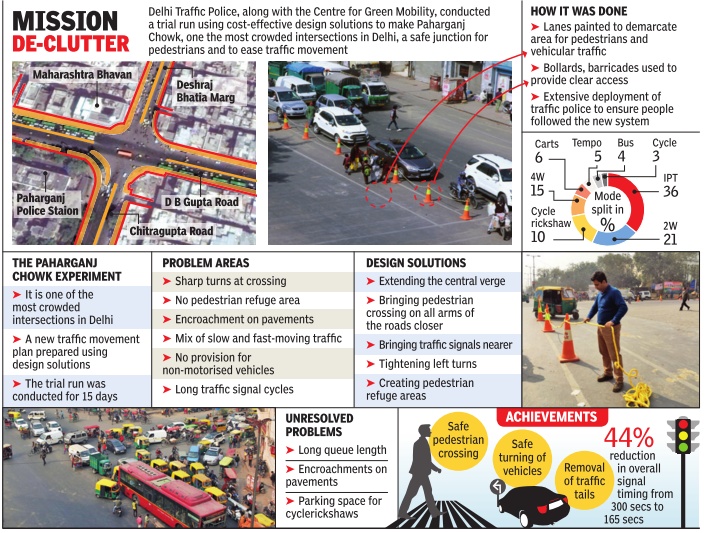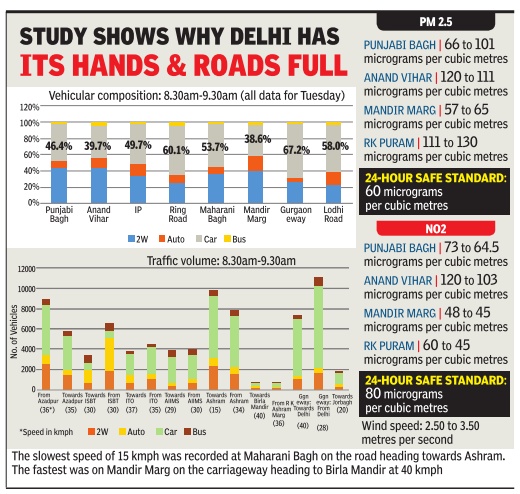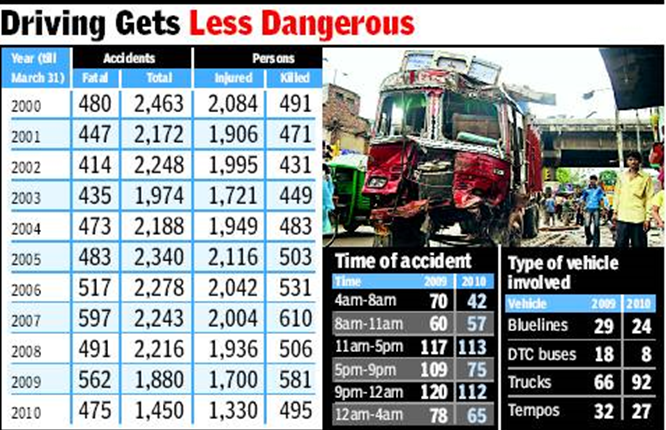Delhi: traffic and road accidents
(→2010) |
|||
| Line 12: | Line 12: | ||
[[Category:Economy-Industry-Resources |D ]] | [[Category:Economy-Industry-Resources |D ]] | ||
| − | =2010= | + | =2010: fewer accidents= |
Study shows fewer accidents in 2010 | Study shows fewer accidents in 2010 | ||
Revision as of 16:17, 3 December 2016

This is a collection of articles archived for the excellence of their content. |
Contents |
2010: fewer accidents
Study shows fewer accidents in 2010
Delhi Police Says Number Of Mishaps Down By 15.5% In First Three Months
Megha Suri Singh | TNN
Delhi roads seem to be becoming much safer if the accident figures compiled by the Delhi Police for the first three months of this year are to be believed. The study reveals that the number of accidents reported this year — 1,450 — is the lowest the city has seen in the past decade. Traffic police attributes it to increasing congestion and therefore reduced speeds, phase-wise completion of large construction projects and large presence of cops on the roads during rush hours.
A look at the figures reveals that 495 people have been killed in accidents this year (till March 31) and another 1,330 people suffered injuries. There has been a decline of about 15.5% in the total number of accidents. Trucks continue to be the major killers as they have been involved in 92 accidents, followed by Bluelines with 24 accidents and Delhi Transport Corporation (DTC) buses with 8 accidents.
Over the years, the highest number of accidents has been reported in the wee hours of the day (midnight to 4am) and this year too, 65 accidents occurred during this time. But the maximum number of accidents — 120 — have taken place between 9pm and 12pm. This is about eight accidents less than the figure for last year.
Senior traffic police officials feel it is not possible to attribute the reduction in accidents to any one reason. But a recent mandate to post traffic policemen at all the intersections in the city during the morning and evening rush hour could have been a factor.
‘‘We have shifted the focus from enforcement to traffic management during the morning and evening rush hour. Now, every traffic signal in the city is physically manned by policemen. Wewould have taken a hit on prosecution, but the focus is on better traffic management,’’ said an official.
Police sources say that the average speed on several key corridors like Ring Road, where people could earlier speed has also reduced due to congestion and traffic jams. This, they said, also could have translated into fewer accidents.
Paharganj decongestion: 2016
The Times of India, April 25, 2016

2014-15: Major traffic offences in Delhi



The Times of India, Aug 15 2015
Somreet Bhattacharya
Jumping signal and illegal parking vie for top honours in challan book
It doesn't take much to throw Delhi's traffic out of gear.A car changing lanes at the last moment, a bus stopping to pick up passengers or an auto parked on the roadside can do it. All of these fall under the category of minor traffic violations but their effect on the city and its stress levels is enormous. So is the number of these violations.Although only a minority of errant drivers gets challaned, police records show 3.4 lakh prosecutions for wrong parking till July 2015. “There is a general disregard for the law,“ says Muktesh Chander, special commissioner, traffic. He says people are not afraid to break traffic rules as the fines are paltry . “People flout rules and then argue to justify their actions. Flouting traffic norms has become a habit, especially during the peak hours.“
Traffic experts say population growth and lack of a public transit system are also responsible for the increasingly unruly driving on Delhi's roads. Surprisingly, the number of challans issued for jumping signals has come down from 4.78 lakh in the first seven months of 2014 to 2.86 lakh during the same period this year. Challans for wrong parking have also reduced from 4.5 lakh to 3.4 lakh. But police say this is a result of the driver sensitization programme and “dynamic prosecution“ they undertook last year.
In 2015, police have cracked down on drivers jumping lanes and crossing divider lines. The number of challans for these offences has increased from 52,850 in the first seven months of 2014 to 937 this year.
Police say 30% of the offenders drive autos, RTVs and Gramin Sewa vehicles while the rest are private car owners. A police study shows the number of challans issued is roughly the same as the number of licensed drivers in the city . However, many of the drivers have been challaned more than once for the same offence.
Traffic expert K K Kapila from International Road Federations says challaning does not discipline drivers anymore as the fines are paltry. Also, heavy traffic at all times of the day enables people to get away with violations because there aren't enough policemen around. The law needs to be strong to deter drivers from breaking rules, he says.
Once the much-delayed Integrated Traffic Management System is in place, private firms will monitor violations and challans will be sent directly to vehicle owners. “We need a foolproof vehicle registration system for this,“ said a traffic official.
